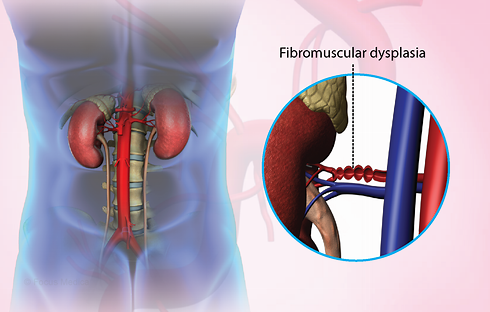Fibromuscular Dysplasia
By Suyuan Tan, MS III
Have you ever had blood pressure that is high no matter how much you watch your health? Not only that, but you sometimes you get this annoying, pulsatile headache that just won’t go away. Your symptoms may be indicative of fibromuscular dysplasia, a vascular disorder that affects over 9% of women.
How does FMD happen?
Fibromuscular dysplasia essentially happens when there is irregular thickening of the blood vessel wall. On imaging, this could look like a bead or chain of beads sitting on your arteries. This curious disease has a natural predilection for the blood vessel that supplies the kidney, called the renal artery. This is why over 70% of the cases of FMD results in lifestyle-refractory hypertension: reduced blood flow to the kidney causes part of the tissue to die, resulting in the kidney releasing a hormone called renin, which in turn causes a chain of reactions that increases salt and water retention, leading to increased blood pressure. Another common location for FMD is the carotid artery, the main artery in your neck, which could cause a pulsating headache.
Is FMD deadly?
While it is an aspect of your health that you need to monitor, FMD rarely is a cause of primary mortality. FMD itself is a non-progressive disease: once you are diagnosed, you are unlikely to further develop FMD in other arteries. However, it could lead to some organ complications. If affecting the renal artery, FMD could eventually cause kidney dysfunction. FMD could also cause dissection of the carotid artery. This could be managed medically or with stenting.
So how do I know I have FMD?
As stated before, over 70% of patients with FMD have high blood pressure. Patients with FMD affecting the carotid artery could develop a headache. Other common manifestations of FMD include tinnitus, neck pain, flank pain, and abdominal pain. Less common symptoms include stroke and mini-stroke. On physical examination, your doctor may report to hear a small bruit when listening to your flank or abdomen with the bell of a stethoscope.
So my doctor thinks I have FMD. Now what?
If your physician suspects that you have FMD, he will order imaging to confirm the diagnosis. The most likely imaging he will order is a CT angiography, which uses X ray radiation to examine your blood vessels. A dye will be injected into your vessels to enhance imaging of your vessels. If, by any chance, your body is intolerant to this dye, a magnetic resonance angiography will be ordered. Regardless of the imaging technique, the radiologist will look for a “beads on a string” appearance to confirm diagnosis of FMD.
How is FMD treated
Treatment options for FMD depends on where the lesion is. For patients with renal FMD, the general treatment is to control hypertension with at least two antihypertensive medications, which include, but are not limited to, ACE inhibitors like Prinivil and ARBs like losartan. If the patient fails medication regimen, surgical revascularization is recommended. Patients with FMD to the carotid artery are managed with aspirin, with stenting if the patient is symptomatic.
Go Back How does FMD happen?
Fibromuscular dysplasia essentially happens when there is irregular thickening of the blood vessel wall. On imaging, this could look like a bead or chain of beads sitting on your arteries. This curious disease has a natural predilection for the blood vessel that supplies the kidney, called the renal artery. This is why over 70% of the cases of FMD results in lifestyle-refractory hypertension: reduced blood flow to the kidney causes part of the tissue to die, resulting in the kidney releasing a hormone called renin, which in turn causes a chain of reactions that increases salt and water retention, leading to increased blood pressure. Another common location for FMD is the carotid artery, the main artery in your neck, which could cause a pulsating headache.
Is FMD deadly?
While it is an aspect of your health that you need to monitor, FMD rarely is a cause of primary mortality. FMD itself is a non-progressive disease: once you are diagnosed, you are unlikely to further develop FMD in other arteries. However, it could lead to some organ complications. If affecting the renal artery, FMD could eventually cause kidney dysfunction. FMD could also cause dissection of the carotid artery. This could be managed medically or with stenting.
So how do I know I have FMD?
As stated before, over 70% of patients with FMD have high blood pressure. Patients with FMD affecting the carotid artery could develop a headache. Other common manifestations of FMD include tinnitus, neck pain, flank pain, and abdominal pain. Less common symptoms include stroke and mini-stroke. On physical examination, your doctor may report to hear a small bruit when listening to your flank or abdomen with the bell of a stethoscope.
So my doctor thinks I have FMD. Now what?
If your physician suspects that you have FMD, he will order imaging to confirm the diagnosis. The most likely imaging he will order is a CT angiography, which uses X ray radiation to examine your blood vessels. A dye will be injected into your vessels to enhance imaging of your vessels. If, by any chance, your body is intolerant to this dye, a magnetic resonance angiography will be ordered. Regardless of the imaging technique, the radiologist will look for a “beads on a string” appearance to confirm diagnosis of FMD.
How is FMD treated
Treatment options for FMD depends on where the lesion is. For patients with renal FMD, the general treatment is to control hypertension with at least two antihypertensive medications, which include, but are not limited to, ACE inhibitors like Prinivil and ARBs like losartan. If the patient fails medication regimen, surgical revascularization is recommended. Patients with FMD to the carotid artery are managed with aspirin, with stenting if the patient is symptomatic.
